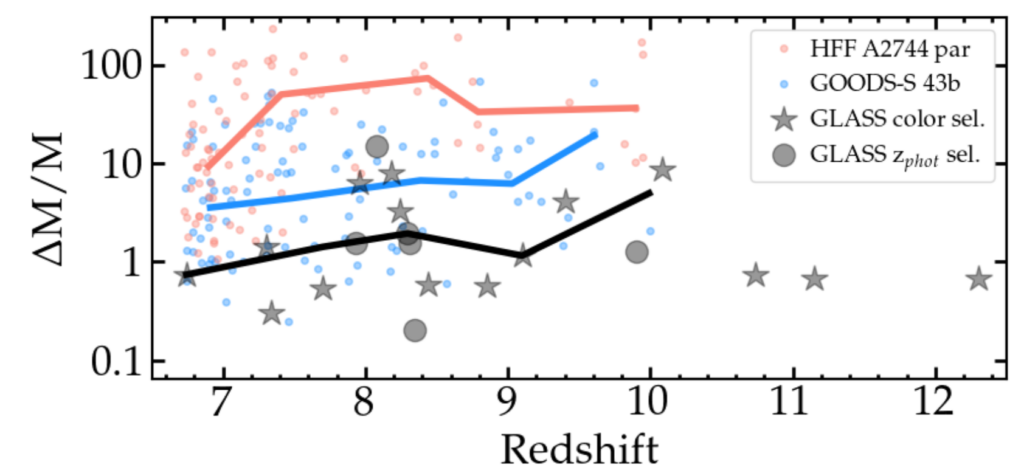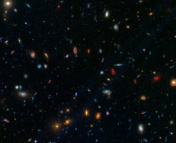Title: Early results from GLASS-JWST. XI: Stellar masses and mass-to-light ratio of z > 7 galaxies
Authors: P. Santini, A. Fontana, M. Castellano, N. Leethochawalit, M. Trenti, T. Treu, D. Belfiori, S. Birrer, A. Bonchi, E. Merlin, C. Mason, T. Morishita, M. Nonino, D. Paris, G. Polenta, P. Rosati, L. Yang, M. Bradac, A. Calabrò, A. Dressler, K. Glazebrook, D. Marchesini, S. Mascia, T. Nanayakkara, L. Pentericci, G. Roberts-Borsani, C. Scarlata, B. Vulcani, Xin Wang
First Author’s Institution: INAF – Osservatorio Astronomico di Roma, via di Frascati 33, 00078 Monte Porzio Catone, Italy
Status: Submitted to ApJ Letters
Astronomers all over the world have been clamoring to analyze the first images from the James Webb Space Telescope (JWST), which were released a few short weeks ago. Currently, JWST is looking at targets for the Early Release Science observations, for which proposals were accepted five years ago in 2017! These observations take place in the first five months of JWST’s science operations, and are publicly available to help astronomers learn how to analyze JWST data. One of these successful proposals, “Through the Looking GLASS,” focuses on studying galaxy formation and evolution throughout history. The GLASS team has clearly been hard at work since the release of their observations on June 28-29, 2022, having since already submitted 12 analysis papers to the arXiv!
Measuring the stellar content of high-redshift galaxies

This paper from the GLASS team focuses on the stellar mass of early galaxies with redshift z > 7. The stellar mass is the mass of all the stars in a given galaxy, as opposed to the total mass, which also includes the galaxy’s dark matter and gas mass. Reliably measuring the stellar mass of a galaxy is crucial to understanding how galaxies form and evolve over time. Generally, the stellar mass is calculated by fitting stellar population synthesis models to the flux of stars in the ultraviolet, optical, and near-infrared wavelengths. From the observed multiwavelength emissions, this method infers the stellar populations in that galaxy . For example, redder emission could indicate an abundance of older, red giant branch stars. However, this method hinges on the availability of optical and near-infrared photometry. The Hubble Space Telescope (HST) has provided exquisite photometry for galaxies in this wavelength range up to a redshift of about z = 3. For galaxies with redshift larger than z = 6; however, many of these stellar population synthesis analyses have missed large fractions of emission from intrinsically red galaxies because of the lack of high-sensitivity and high-resolution photometry.
This story completely changed with the advent of JWST, which has provided extremely high-precision near-infrared photometry of early galaxies. This paper studied 21 galaxies in the redshift range 7<z<12, and is actually the first analysis of this kind for galaxies above z > 7. Using the software ZPHOT, the authors determined the stellar mass of each of the galaxies using the JWST photometry in seven different photometric bands.

The authors found that their measured stellar masses were more precise by a factor of 2 to 10 than the two highest quality data sets available before JWST, which were obtained from a combination of HST, Spitzer, and ground-based telescopes. Figure 1 shows how the uncertainty on the stellar mass as a function of redshift was significantly lowered using JWST observations.
Characterizing the mass-luminosity (M/L) correlation with JWST
The authors then studied the relation between mass and luminosity for lyman-break galaxies (LBGs), which are star-forming galaxies at a high redshift. This relation, the M/L relation, can reveal information about the physical properties in early galaxies. For example, spiral galaxies, which have many brighter, younger stars, often have smaller M/L ratios than elliptical galaxies, which have more older, dimmer stars. Previous studies have found positive correlations between brightness and mass of LBG galaxies, where brighter galaxies are more massive. However, this study found only a small correlation between mass and brightness for their galaxy sample (Pearrson coefficient = -0.29), which is shown in Figure 2.
This paper also investigated the M/L ratio as a function of redshift, finding it spanned two orders of magnitude in their sample. This result implied that these early, high-redshift galaxies are heterogeneous, and cover a broad variety of star formation histories and morphologies.
In conclusion, this study demonstrated the power of JWST for studying high redshift galaxies and their stellar masses. The GLASS team is excited to continue to refine their analysis of early galaxies with future JWST observations.
Astrobite edited by Zili Shen
Featured image credit: BBC Science Focus




